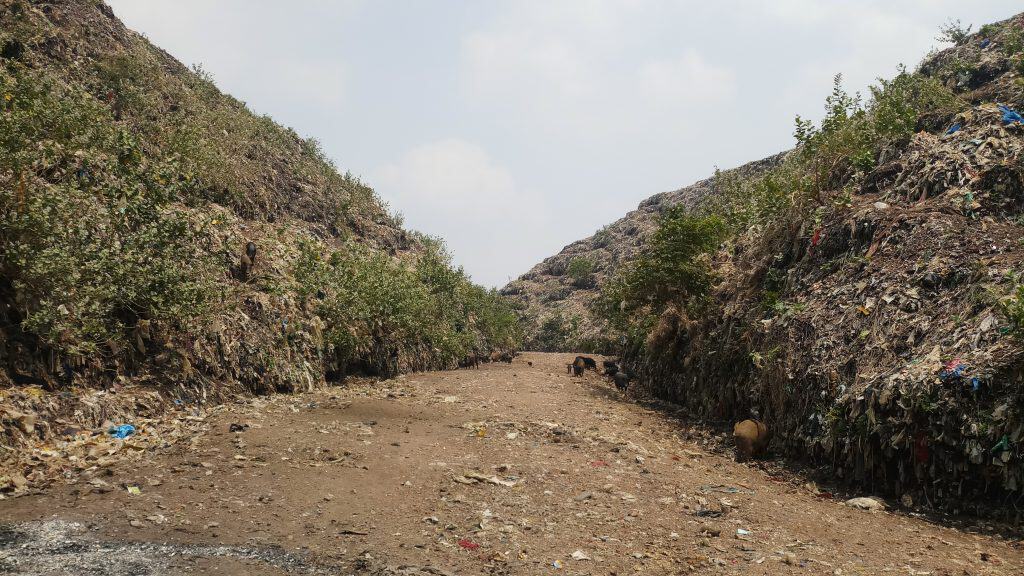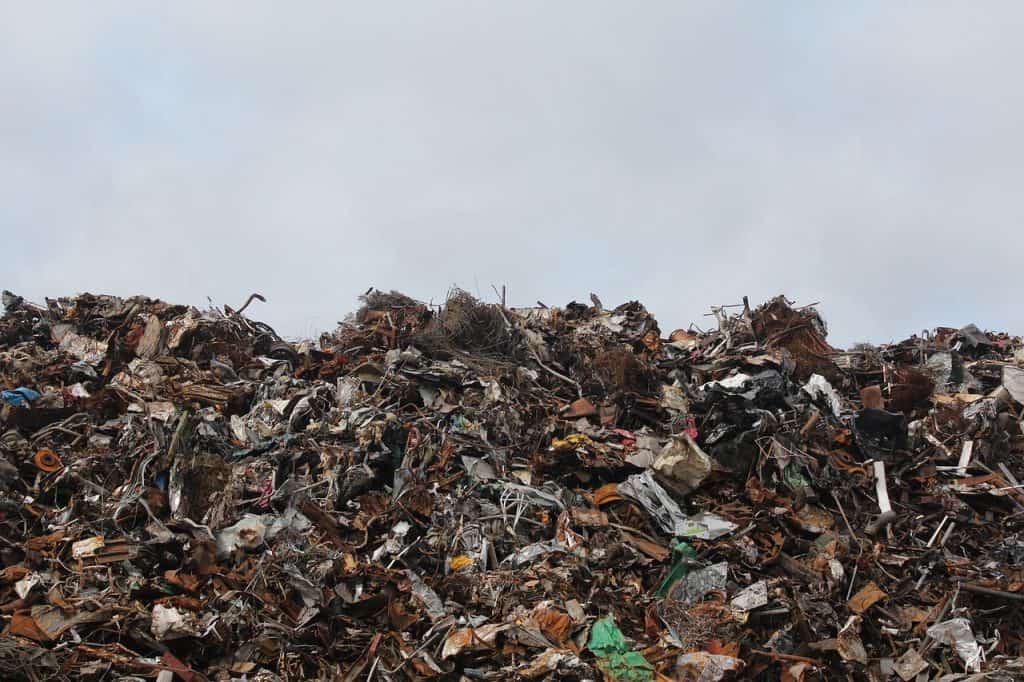In 2019, the Indore Municipal Corporation became the first Indian city to clear around 15 lakh tonnes of historic waste at landfills using a process called bioremediation. With overflowing landfills and the difficulty of finding new waste disposal sites, Urban Local Bodies (ULBs) across the country now look at the Indore project as an example worth emulating to clear out waste dumps at landfills.
Cities like Bijapur, Davanagere, Doddaballapur, and most recently, Hassan and Gokak have already invited Expressions of Interest or tenders for conducting bioremediation. While this may result in reclaiming some land from waste disposal sites, several challenges remain such as continuous addition of fresh waste to the site, frequent fire hazards and increased costs.
Read more: Kolkata plans its first biomining project at Mollar Bheri landfill on eastern wetland
What is bioremediation?
Bioremediation of historic or legacy waste refers to the processing of old waste disposed over years and salvaging any possible recyclables to recover the land for future use. It is usually conducted by opening capped/uncapped waste heaps; sieving them to separate organic and inorganic waste; recovering valuables, if any, and systematically capping the rejects.
ULBs across the country have been disposing of collected waste without much processing, and the quantity of waste generation has increased over the past three decades with the rapid growth of urban areas. Indian cities generate about 1.5 lakh tonnes of municipal solid waste per day, of which more than 80 per cent is not processed. This means almost 4 crore tons of waste is dumped in landfills every year, without processing.
Read more: Where does the plastic waste in Indian cities go?
On an average about 15-20 acres of land is dedicated by ULBs to the disposal of waste in each of about 7,000 urban areas in the country, accounting for more than 1 lakh acres of land. That is, nearly half the size of the city of Bengaluru is now locked as waste disposal sites.

While ULBs have progressed in terms of more efficient waste collection, processing itself has mostly translated to dumping at landfills still. With accumulation over decades, it may not be possible to dump any more waste at these sites without first clearing existing waste and reclaiming land, which is pushing ULBs to take up bioremediation.
With escalating land prices, finding a new landfill for waste disposal is a nightmare for administrators in urban areas. Additionally, increased public awareness about the unscientific processing of waste and its implications on the local environment would fuel opposition to the creation of new landfills.
Read more: How one of Delhi’s tallest structures is contributing to climate change
Unprocessed waste in landfills emit odour, contaminate groundwater, attract stray dogs, pollute the air, catch fire and, more importantly, hinder the growth and potential of that area. This further motivates ULBs to try and recover land from existing waste disposal sites using techniques like bioremediation.
Bioremediation projects last for about 9-12 months depending on the quantity of the waste. This can be tendered out as a time-bound project, unlike waste processing which is a routine, recurring activity. These projects also get political mileage as they have an end date with visible results indicating a ‘before’ and ‘after’.
But while bioremediation appears easier and more feasible than the routine processing of waste, it has several challenges.
The downside
When fresh waste is processed, the organic part is converted to compost and some parts of the inorganic waste is sent to recycling units. Historic waste, left unattended for years on the other hand, may not have any nutrient value and cannot be converted to good quality compost.
Fresh waste generated in Indian cities consist of about 55-60% biodegradable material, 20-25 per cent recyclable waste and 15-20 per cent inert materials, according to CPHEEO (Central Public Health and Environmental Engineering Organisation). Historic waste largely consists of inert material and debris. With years of degradation and frequent fire accidents, ash content and volatile materials also end up contributing to historic waste.
The recoverables from historic waste are not fit for recycling and hence do not fetch value. The only potential use of the sieved historic waste could be to fill low-lying areas, but this cannot be a revenue source since construction debris is abundantly available for this purpose. The other recoverable in processing historic waste is half-burnt plastic, which also has no commercial value.

A popular belief is that bioremediation can reduce the volume of waste and thus lead to the recovery of much-needed land in urban areas. Some ULBs are hoping to recover as much as 90 per cent of the land currently used as landfills. However, bioremediation projects only recover a portion of recyclables, and since most moisture content of waste is lost in the first month of waste disposal, it is unlikely that there will be significant reduction in the volume of historic waste.
As part of the bioremediation process, the historic waste, after sieving, is reorganised systematically, divided into piles of greater height than haphazard disposal and then compacted. The closed landfill can also be landscaped. This reorganisation can help ULBs reclaim around 60-70 per cent of land after processing and compaction (author’s estimates), but it is important to remember that it is not possible to recover all the land occupied by landfills.
Economies of processing fresh waste
Typically, the processing of fresh waste costs about Rs 1,500 per tonne, and the processing of historic waste costs Rs 700-800 per ton depending on the location, quantity and type of waste. However, about 40% of the money spent on processing fresh waste (excluding transportation) can be recovered by selling the organic compost (which is subsidised by the central government) and other recyclable material like plastic and metal pieces.
Historic waste, in addition to the project cost of bioremediation, also forces ULBs to spend money annually on a range of issues such as fire incidents, landfill accidents, groundwater contamination and legal fees. Most landfills tend to catch fire in the summer due to high temperature and high calorific value of the material. Each fire incident could cost the ULB lakhs of rupees, and all of this annual expenditure does not usually get accounted for when a bioremediation project’s cost is estimated.
For instance, fire incidents at the BBMP’s waste processing unit at Kannahalli in 2016 caused an estimated loss of Rs. 9 crore, and just a few weeks ago, five dry waste collection centres in Bengaluru were destroyed in fires.
Handling waste while it is still fresh is a challenging job to carry out regularly, but considering the environmental hazards of accumulating waste (as landfills generate dangerous methane gases), handling historic waste is far more challenging and expensive than fresh waste. Processing of fresh waste can reduce the volume of waste to less than 15-20 per cent through loss of moisture content and removal of recyclables and its by-products, thus making this the sustainable, cost-effective and feasible option.
Bioremediation can be a part of the solution to addressing India’s mounting problems with waste, as it helps to tackle the lakhs of tonnes of garbage already accumulated at landfills across the country. It has the potential to free up land and reduce the risk of pollution. But going forward, it is critical to frame policies that recognise the simple fact that waste is best handled fresh and before it is allowed to accumulate.
Also read:
Well written article. Hope the Urban Local Bodies dedicate much required resources to clean this up as early as possible. Urban Local Bodies are punishing the villages where landfills are located through all the nuisance. Villages located near landfill sites are leading a miserable life due to bad smell, leachate, groundwater contamination, too many flies and other discomforts.
Good one. Awareness to people is very much required. People living around the waste sites are facing problems, municipalities should start working on this as early as possible
Thank you Chandrakala. Hope municipalities start working on this soon.